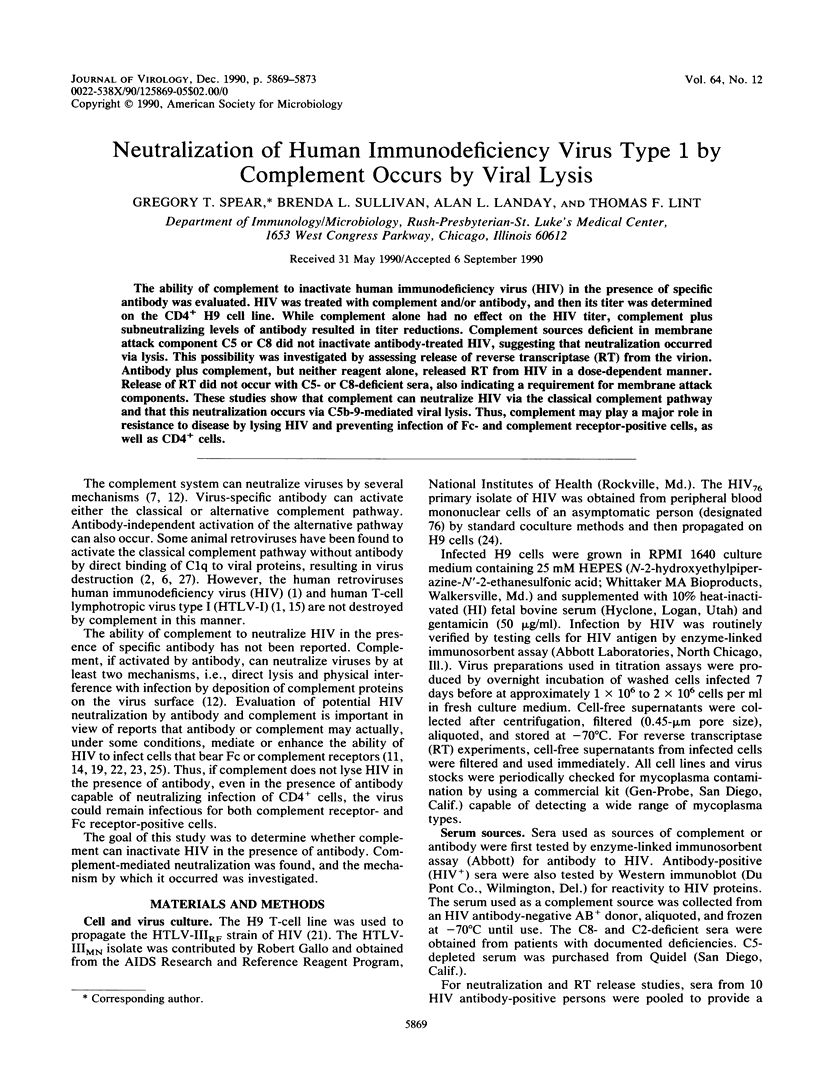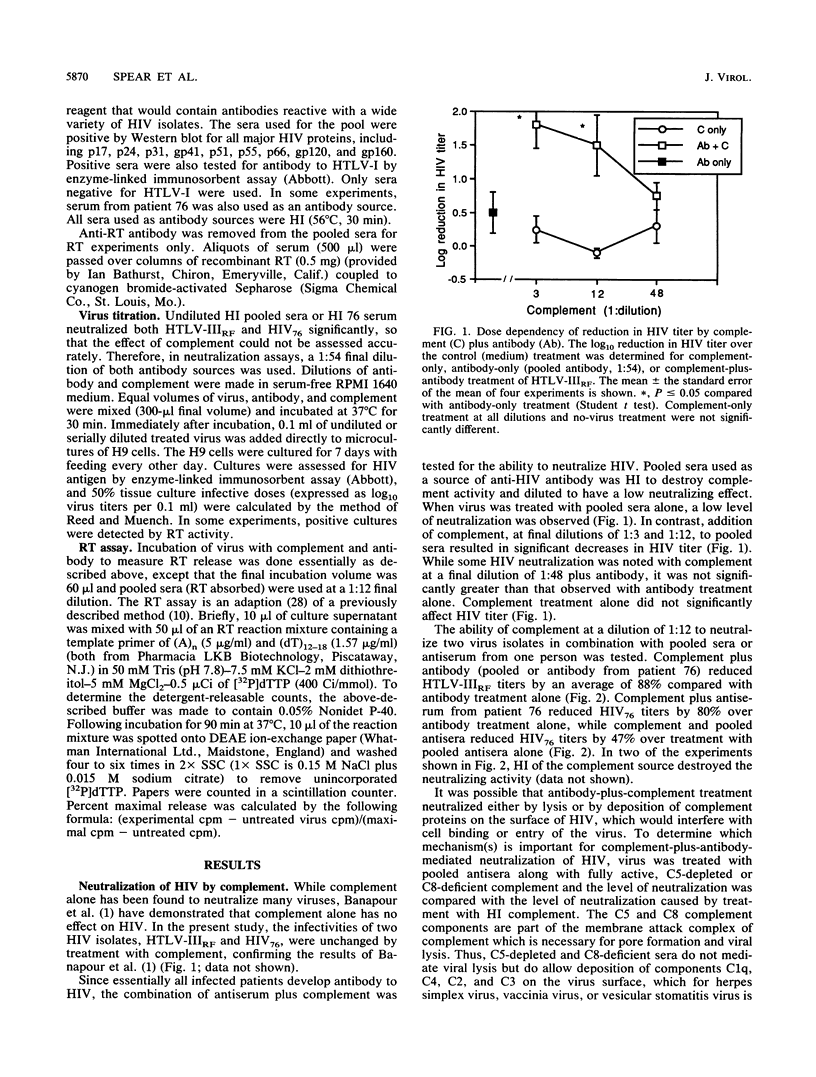Abstract
The ability of complement to inactivate human immunodeficiency virus (HIV) in the presence of specific antibody was evaluated. HIV was treated with complement and/or antibody, and then its titer was determined on the CD4+ H9 cell line. While complement alone had no effect on the HIV titer, complement plus subneutralizing levels of antibody resulted in titer reductions. Complement sources deficient in membrane attack component C5 or C8 did not inactivate antibody-treated HIV, suggesting that neutralization occurred via lysis. This possibility was investigated by assessing release of reverse transcriptase (RT) from the virion. Antibody plus complement, but neither reagent alone, released RT from HIV in a dose-dependent manner. Release of RT did not occur with C5- or C8-deficient sera, also indicating a requirement for membrane attack components. These studies show that complement can neutralize HIV via the classical complement pathway and that this neutralization occurs via C5b-9-mediated viral lysis. Thus, complement may play a major role in resistance to disease by lysing HIV and preventing infection of Fc- and complement receptor-positive cells, as well as CD4+ cells.
Full text
PDF




Selected References
These references are in PubMed. This may not be the complete list of references from this article.
- Antibody-dependent enhancement of HIV infection. Lancet. 1988 Jun 4;1(8597):1285–1286. [PubMed] [Google Scholar]
- Banapour B., Sernatinger J., Levy J. A. The AIDS-associated retrovirus is not sensitive to lysis or inactivation by human serum. Virology. 1986 Jul 15;152(1):268–271. doi: 10.1016/0042-6822(86)90392-2. [DOI] [PubMed] [Google Scholar]
- Bartholomew R. M., Esser A. F., Müller-Eberhard H. J. Lysis of oncornaviruses by human serum. Isolation of the viral complement (C1) receptor and identification as p15E. J Exp Med. 1978 Mar 1;147(3):844–853. doi: 10.1084/jem.147.3.844. [DOI] [PMC free article] [PubMed] [Google Scholar]
- Bolognesi D. P. AIDS. Do antibodies enhance the infection of cells by HIV? Nature. 1989 Aug 10;340(6233):431–432. doi: 10.1038/340431a0. [DOI] [PMC free article] [PubMed] [Google Scholar]
- Carini C., Perricone R., Fratazzi C., Fontana L., De Carolis C., D'Amelio R., Sirianni M. C., Aiuti F. Complement activation is associated with the presence of specific human immunodeficiency virus (HIV)-anti-HIV immune complexes in patients with acquired immunodeficiency syndrome-related complex or lymphoadenopathy syndrome. Scand J Immunol. 1989 Sep;30(3):347–353. doi: 10.1111/j.1365-3083.1989.tb01220.x. [DOI] [PubMed] [Google Scholar]
- Coombs R. W., Collier A. C., Allain J. P., Nikora B., Leuther M., Gjerset G. F., Corey L. Plasma viremia in human immunodeficiency virus infection. N Engl J Med. 1989 Dec 14;321(24):1626–1631. doi: 10.1056/NEJM198912143212402. [DOI] [PubMed] [Google Scholar]
- Cooper N. R., Jensen F. C., Welsh R. M., Jr, Oldstone M. B. Lysis of RNA tumor viruses by human serum: direct antibody-independent triggering of the classical complement pathway. J Exp Med. 1976 Oct 1;144(4):970–984. doi: 10.1084/jem.144.4.970. [DOI] [PMC free article] [PubMed] [Google Scholar]
- Cooper N. R., Nemerow G. R. Complement and infectious agents: a tale of disguise and deception. Complement Inflamm. 1989;6(4):249–258. doi: 10.1159/000463100. [DOI] [PubMed] [Google Scholar]
- Daniels C. A., Borsos T., Rapp H. J., Snyderman R., Notkins A. L. Neutralization of sensitized virus by purified components of complement. Proc Natl Acad Sci U S A. 1970 Mar;65(3):528–535. doi: 10.1073/pnas.65.3.528. [DOI] [PMC free article] [PubMed] [Google Scholar]
- Ehrnst A., Sönnerborg A., Bergdahl S., Strannegård O. Efficient isolation of HIV from plasma during different stages of HIV infection. J Med Virol. 1988 Sep;26(1):23–32. doi: 10.1002/jmv.1890260105. [DOI] [PubMed] [Google Scholar]
- Goff S., Traktman P., Baltimore D. Isolation and properties of Moloney murine leukemia virus mutants: use of a rapid assay for release of virion reverse transcriptase. J Virol. 1981 Apr;38(1):239–248. doi: 10.1128/jvi.38.1.239-248.1981. [DOI] [PMC free article] [PubMed] [Google Scholar]
- Hirsch R. L. The complement system: its importance in the host response to viral infection. Microbiol Rev. 1982 Mar;46(1):71–85. doi: 10.1128/mr.46.1.71-85.1982. [DOI] [PMC free article] [PubMed] [Google Scholar]
- Ho D. D., Moudgil T., Alam M. Quantitation of human immunodeficiency virus type 1 in the blood of infected persons. N Engl J Med. 1989 Dec 14;321(24):1621–1625. doi: 10.1056/NEJM198912143212401. [DOI] [PubMed] [Google Scholar]
- Homsy J., Meyer M., Tateno M., Clarkson S., Levy J. A. The Fc and not CD4 receptor mediates antibody enhancement of HIV infection in human cells. Science. 1989 Jun 16;244(4910):1357–1360. doi: 10.1126/science.2786647. [DOI] [PubMed] [Google Scholar]
- Hoshino H., Tanaka H., Miwa M., Okada H. Human T-cell leukaemia virus is not lysed by human serum. 1984 Jul 26-Aug 1Nature. 310(5975):324–325. doi: 10.1038/310324a0. [DOI] [PubMed] [Google Scholar]
- Laurence J., Saunders A., Kulkosky J. Characterization and clinical association of antibody inhibitory to HIV reverse transcriptase activity. Science. 1987 Mar 20;235(4795):1501–1504. doi: 10.1126/science.2435004. [DOI] [PubMed] [Google Scholar]
- Leddy J. P., Simons R. L., Douglas R. G. Effect of selective complement deficiency on the rate of neutralization of enveloped viruses by human sera. J Immunol. 1977 Jan;118(1):28–34. [PubMed] [Google Scholar]
- Lin R. Y., Wildfeuer O., Franklin M. M., Candido K. Hypocomplementemia and human immunodeficiency virus infection. Clinical correlates and relationships to circulating immune complex and immunoglobulin G levels. Int Arch Allergy Appl Immunol. 1988;87(1):40–46. doi: 10.1159/000234646. [DOI] [PubMed] [Google Scholar]
- Matsuda S., Gidlund M., Chiodi F., Cafaro A., Nygren A., Morein B., Nilsson K., Fenyö E. M., Wigzell H. Enhancement of human immunodeficiency virus (HIV) replication in human monocytes by low titres of anti-HIV antibodies in vitro. Scand J Immunol. 1989 Oct;30(4):425–434. doi: 10.1111/j.1365-3083.1989.tb02446.x. [DOI] [PubMed] [Google Scholar]
- Perricone R., Fontana L., de Carolis C., Carini C., Sirianni M. C., Aiuti F. Evidence for activation of complement in patients with AIDS related complex (ARC) and/or lymphoadenopathy syndrome (LAS). Clin Exp Immunol. 1987 Dec;70(3):500–507. [PMC free article] [PubMed] [Google Scholar]
- Popovic M., Sarngadharan M. G., Read E., Gallo R. C. Detection, isolation, and continuous production of cytopathic retroviruses (HTLV-III) from patients with AIDS and pre-AIDS. Science. 1984 May 4;224(4648):497–500. doi: 10.1126/science.6200935. [DOI] [PubMed] [Google Scholar]
- Robinson W. E., Jr, Montefiori D. C., Gillespie D. H., Mitchell W. M. Complement-mediated, antibody-dependent enhancement of HIV-1 infection in vitro is characterized by increased protein and RNA syntheses and infectious virus release. J Acquir Immune Defic Syndr. 1989;2(1):33–42. [PubMed] [Google Scholar]
- Robinson W. E., Jr, Montefiori D. C., Mitchell W. M., Prince A. M., Alter H. J., Dreesman G. R., Eichberg J. W. Antibody-dependent enhancement of human immunodeficiency virus type 1 (HIV-1) infection in vitro by serum from HIV-1-infected and passively immunized chimpanzees. Proc Natl Acad Sci U S A. 1989 Jun;86(12):4710–4714. doi: 10.1073/pnas.86.12.4710. [DOI] [PMC free article] [PubMed] [Google Scholar]
- Spear G. T., Landay A. L., Sullivan B. L., Dittel B., Lint T. F. Activation of complement on the surface of cells infected by human immunodeficiency virus. J Immunol. 1990 Feb 15;144(4):1490–1496. [PubMed] [Google Scholar]
- Takeda A., Tuazon C. U., Ennis F. A. Antibody-enhanced infection by HIV-1 via Fc receptor-mediated entry. Science. 1988 Oct 28;242(4878):580–583. doi: 10.1126/science.2972065. [DOI] [PubMed] [Google Scholar]
- Tausk F. A., McCutchan A., Spechko P., Schreiber R. D., Gigli I. Altered erythrocyte C3b receptor expression, immune complexes, and complement activation in homosexual men in varying risk groups for acquired immune deficiency syndrome. J Clin Invest. 1986 Oct;78(4):977–982. doi: 10.1172/JCI112688. [DOI] [PMC free article] [PubMed] [Google Scholar]
- Welsh R. M., Jr, Cooper N. R., Jensen F. C., Oldstone M. B. Human serum lyses RNA tumour viruses. Nature. 1975 Oct 16;257(5527):612–614. doi: 10.1038/257612a0. [DOI] [PubMed] [Google Scholar]
- Willey R. L., Smith D. H., Lasky L. A., Theodore T. S., Earl P. L., Moss B., Capon D. J., Martin M. A. In vitro mutagenesis identifies a region within the envelope gene of the human immunodeficiency virus that is critical for infectivity. J Virol. 1988 Jan;62(1):139–147. doi: 10.1128/jvi.62.1.139-147.1988. [DOI] [PMC free article] [PubMed] [Google Scholar]


